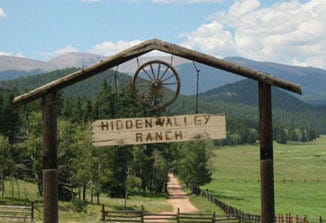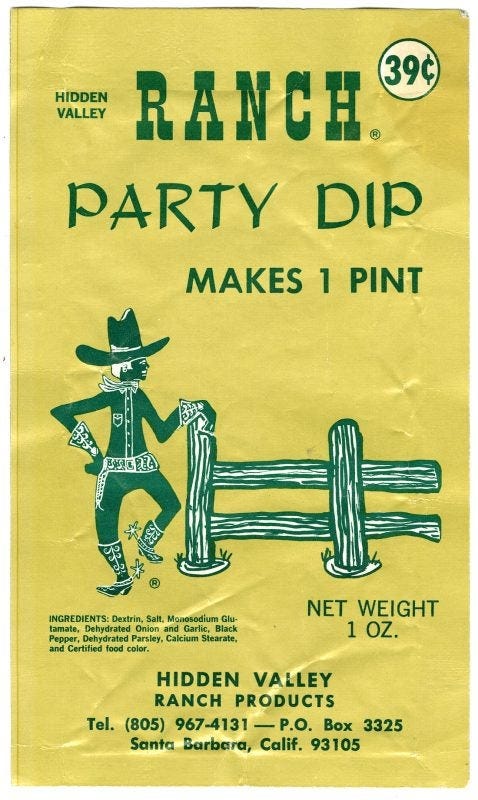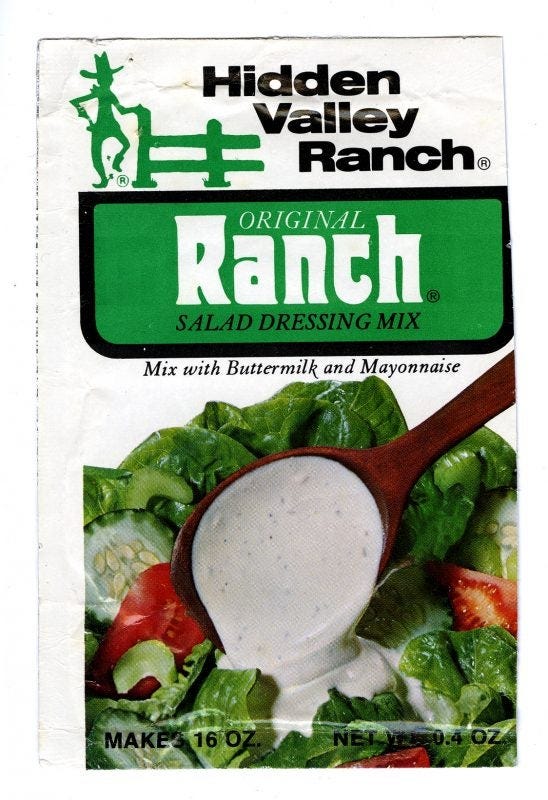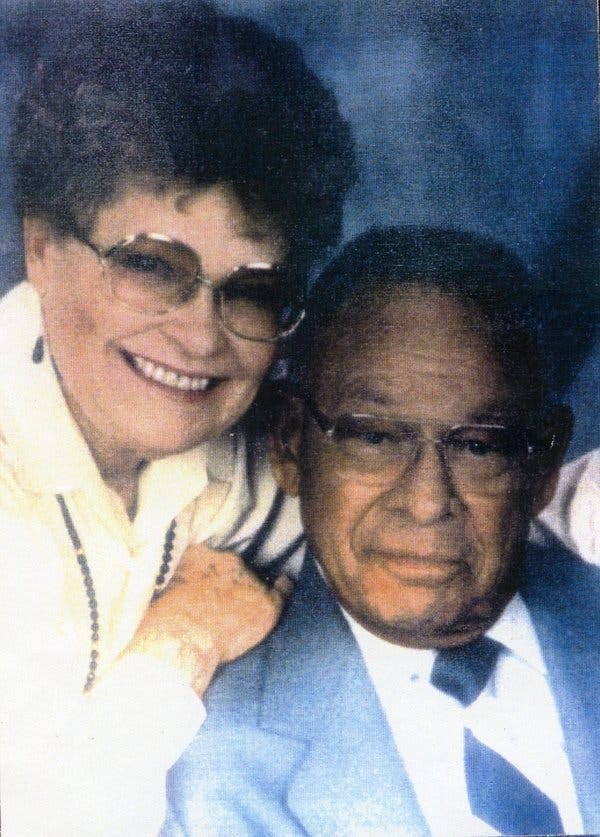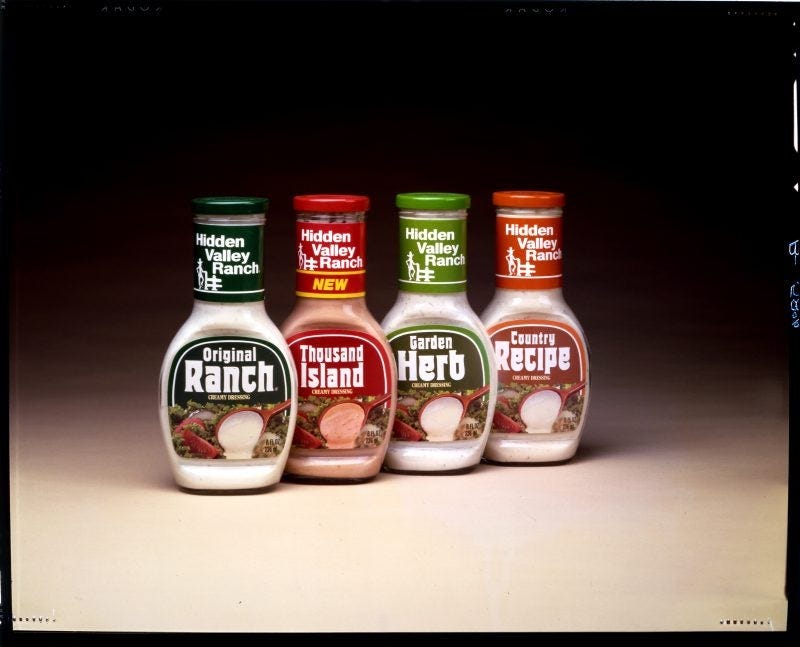Making the First Ranch Dressing Commercial - The Hidden Valley Ranch Story
In the mid 1970's I was the Account Executive at Young & Rubicam assigned to a new salad dressing being introduced by the Clorox corporation in Oakland, California. I was still learning how to be an account executive and my boss, a Management Supervisor I'll call Robert, wasn't much help. Robert didn't get involved with clients and I was pretty much on my own. Robert gave me the name of my client; a Product Manager I'll simply call Mr. Crazy, a nickname you'll soon understand when you hear what he did. Clorox had just recently been split off from its parent, Procter & Gamble, by the FTC on the argument that P&G, with all of its laundry products, was beginning to become a monopoly. The newly independent Clorox had begun to acquire food and other products as P&G had done over the years. This is the story of how I was introduced to the new company and went to Reno, Nevada, to shoot the first commercial for a new salad dressing they had acquired.
My First Clorox Client, Mr. Crazy
I've encountered some difficult clients at times, as every agency guy does, but Mr. Crazy was in a league of his own. I placed my first call to his office in Oakland and couldn't reach him, or leave a message. I continued trying, and when I finally got through, I introduced myself and give him my telephone number. He didn't care about my telephone number because he never intended to call me. He announced he was coming to Young & Rubicam to talk to the creatives, the people who would create the first commercial for his new salad dressing product. I marked the date.
When he arrived, I realized he had no intention of running an informative meeting with me or the creatives to make the first commercial. Instead, he simply said he was busy getting the new salad dressing brand, Hidden Valley Ranch, into test market stores in upper New York state. The problem he had was getting the stores to stock up on Buttermilk quarts before the salad dressing mix packets started to be sold. Said simply, the customer had to buy both the Buttermilk and the mix to create the salad dressing at home. But stores, at the time, only sold Buttermilk in quarts, nothing less. Right away, I sensed something was going wrong. That's a lot of salad dressing to make all at once, unless you're running a restaurant.
My next need was to get his approval on a media budget. We had to start planning media for the intended advertising launch date. Again, I couldn't reach Mr. Crazy by phone. He left me a note that he would be in an upstate New York town on a date in the following week. I decided to travel there to force a meeting, if necessary, to begin planning a media buy. When I got to this town, I went to his motel and tried to talk to him. He was too busy, he said, but he could talk to me at 11:00 p.m. that evening at a local sports bar. That's where he planned to relax with his salesforce people after a hard day of getting stores to stock quarts of Buttermilk. What choice did I have? I went to the sports bar at 11:00 p.m. and it was mobbed. Struggling through the crowd, I found him sitting, drinking, and laughing at a table. I sat down beside him. "I've got to get your approval on a media plan," I said, as politely as I could, half shouting due to the music and talking noise level. He could barely hear me, but after half an hour of back-and-forth shouting, I finally got enough of an okay for an approved budget. But did we really have one? I wasn't sure.
When I got back to Y&R in New York, I gave my boss a complete report and he thought I ought to try to get Mr. Crazy on the phone to verify the media budget decision. Again, I tried to reach him by phone with no success. On the tenth or eleventh time, he answered. I explained why I was calling and asked him to verify his media budget decision. Then there was silence; total silence. So, I repeated my question. He laughed and said he had a new job at Clorox. I asked him what his new job was, and he said: "I'm a crossing guard in front of the corporate parking lot." His sarcastic tone told me he had to be joking, but he then hung up. He had been fired from his product manager job, thank God, now I waited to find out who was going to replace him.
My Second Clorox Client, Mr. Sane
Again, I will use my choice of a nickname, Mr. Sane, and, as you can guess from the nickname, he was the complete opposite of Mr. Crazy. Mr. Sane was one of the most pulled-together, smart product managers I've ever met. He called me and asked to meet with me and the lead writer to start making advertising. I was joyous.
Mr. Sane's office was in Pennsylvania because he was working on another food product for Clorox, a brand of canned mushrooms. That was much closer than Oakland, California. But not all was perfect. The creative assigned to write the first Hidden Valley commercial was a guy I did not get along with, as did many other people at Y&R I later learned. I'll call him "Mr. Difficult". Our first meeting Mr. Sane went well, as I expected, except for the obnoxious behavior of Mr. Difficult. Nevertheless, the account began to finally move ahead, and we decided to make the first commercial using Mr. Steve Henson, the inventory of Hidden Valley Ranch salad dressing, and letting him tell the story of how he invented this new kind of salad dressing. He turned out to be a pretty interesting guy, as you'll soon see. He was living near Reno, Nevada, so Mr. Difficult and I had to now fly to Reno to make the first Hidden Valley Ranch commercial with Steve Henson.
Reno, Nevada, the Divorce Capital of the World
Reno was the second biggest gambling city in Nevada, after Las Vegas, but it also had another tourist attraction; divorce proceedings. The legal details get complicated, but the main reason Reno was the most popular place to seek a divorce in America, was the lax laws they put in place to attract divorce seekers. Apparently, other states back then had punitive laws, attempting to punish people who tried to get a divorce. Reading about the laws back then reminded me of the battles over abortion laws today. Reno wanted the tourist business so they made divorce much easier. It was as simple as that.
Mr. Difficult and I planned a three-day stay to meet Steve Henson and prepare him for his commercial, and it looked like it would be easy enough to complete on time. I loved Reno when I first arrived, but it was amazing how my impression of Reno changed so fast while I was there. On the first day, looking out my motel window, I was dazzled by the purple majesty of the Rocky Mountains against a clear blue sky. By the third day, I was bored out of my skull with the same sight. When I went into the gambling casinos, I was further depressed by the site of elderly ladies getting off buses, coming from nearby assisted living facilities. They would slowly walk into the casino, don their white gloves, and insert one coin at a time, from a paper cup full of the same coins, into their chosen slot machine. They would continue to do this over and over, for almost the entire day, at the same slot machine. They looked like robots. I felt sorry for them, but I guess I shouldn't judge their simple pleasure trip so quickly. Maybe it was the most exciting thing they did.
Steve Henson
Steve Henson was a true American, grassroots pioneer type of guy. He was born in tiny Thayer, Nebraska, in 1918. At 16, he rode the rails to California. There he worked at various occupations until, in 1949, he and his wife, Gayle, moved to Alaska. He enjoyed success as a plumbing contractor in and around Anchorage, and at age 35, he was able to retire. The couple settled in Santa Barbara, but after a year and a half, Henson found himself restlessly searching for something to do. He had always been attracted to ranching, so in 1956, he purchased the Sweetwater Ranch up on San Marcos Pass. He soon renamed the spread Hidden Valley Ranch.
What I loved was his down-to-earth telling of his story, so unlike the version you might read in an official biography. Steve said, "I moved to Alaska to make money. They were paying plumbing contractors a lot of money then because no plumbers wanted to work in the cold, wet bush country. My goal was to be able to buy a car, so big, I couldn't turn it around in the street outside our home in California. I didn't know anything about plumbing when I got there, but those were the best paying jobs so I signed up to be a plumber." His telling of his story reminded me of the men who went to California in 1849 to pan for gold.
The story of how he invented the formula for Hidden Valley salad dressing was equally earthy. He didn't know much about cooking but he had to keep his crews happy and that meant doing something about keeping food from freezing or going sour. The solution all the Alaskan workers used was the same; they put Buttermilk in or on everything. Steve added mayonnaise and some spices to make the salad dressing, but that was the extent of his contribution as a chef. I loved his unvarnished telling of his story.
Clorox Buys Hidden Valley Ranch Dressing
The idea was to operate Hidden Valley Ranch as a guest ranch, offering fishing, riding, hiking, and other outdoor activities. The ranch also offered hearty home-cooked meals. The dude ranch business didn’t make much money, but guests were particularly taken by the unique dressing that graced the salads.
Word began to spread about this wonderful product. Henson mixed up a batch for his friend, Audrey Ovington, owner of Cold Spring Tavern, and the tavern became the first establishment away from the ranch to offer the dressing on its menu. By 1957, Kelley’s Korner, a store at Hollister Avenue (now State Street) and La Cumbre Road, was selling small packages of the dried herbs and spices and could not keep them on the shelves. In one two-day period, the store sold more than 140 packages.
Obviously, Henson was onto something. He began a mail order business at the ranch with packages selling for 75 cents apiece. It was not long until the operation had taken up every room in the family home. By the mid-1960s, the guest ranch, which had never done all that well financially, had been completely taken over by the mail order business. By the late 1960s, the Hensons were filling orders from all 50 states and more than 30 countries.
By the early 1970s, Hidden Valley Ranch dressing had grown much too big for its home. Processing had to move offsite, and the ranch became the corporate headquarters. For a time, the dressing mix was blended at Griffith Laboratories in San Jose then shipped down to Los Angeles to be packaged in a 65,000-square-foot facility at the rate of 35,000 packets every eight hours. Operations were later set up in Colorado and in Nevada.
In 1972, Henson sold the business to the Clorox Company for $8 million and settled down once again to a life of leisure and travel. Ranch dressing remains incredibly popular.
Meeting the Amazing CEO of Clorox
Robert B. Shetterly (1915 – 1997) was the chairman and Chief Executive Officer of Clorox at this time, and I had the pleasure of meeting him at a business meeting he held in California as the brand was launched.
He told everyone, and there were over 50 attendees at this meeting, that his plan was to parallel the success of P&G, the company that owned Clorox before the FTC required its divestiture. This meant he was building a cadre of successful brands from scratch, looking for potential winners early on in the food and cleaning categories. i had heard that he had a reputation for drinking more martinis than anyone else, so I counted the empty martini glasses that accumulated in front of him at the dinner he hosted. They totaled 14, by my count, but when he stood up to speak and then opened the floor for questions, he never slurred or missed a syllable. I felt he was the right choice to make Clorox's future promise come true.
The Bottle Form is Introduced
After purchasing Hidden Valley Ranch mixes, recipes, and name in 1972, Clorox experimented with selling only packets of flavoring that could be added to fresh buttermilk, but finally had to conform to the bottle of prepared dressing that all other salad dressings used.
To me, this means they aren't using natural buttermilk in the bottled version, but they may be using the shelf-stable form now used for milk products. I don’t know. When I Googled the question, "Does Hidden Valley Rach dressing contain fresh buttermilk," I discovered a variation of Ranch dressing specifically with buttermilk added. So, even though the normal bottles you see on the shelves are not necessarily fresh buttermilk, the Hidden Valley Ranch brand now dominates the Ranch dressing category.





